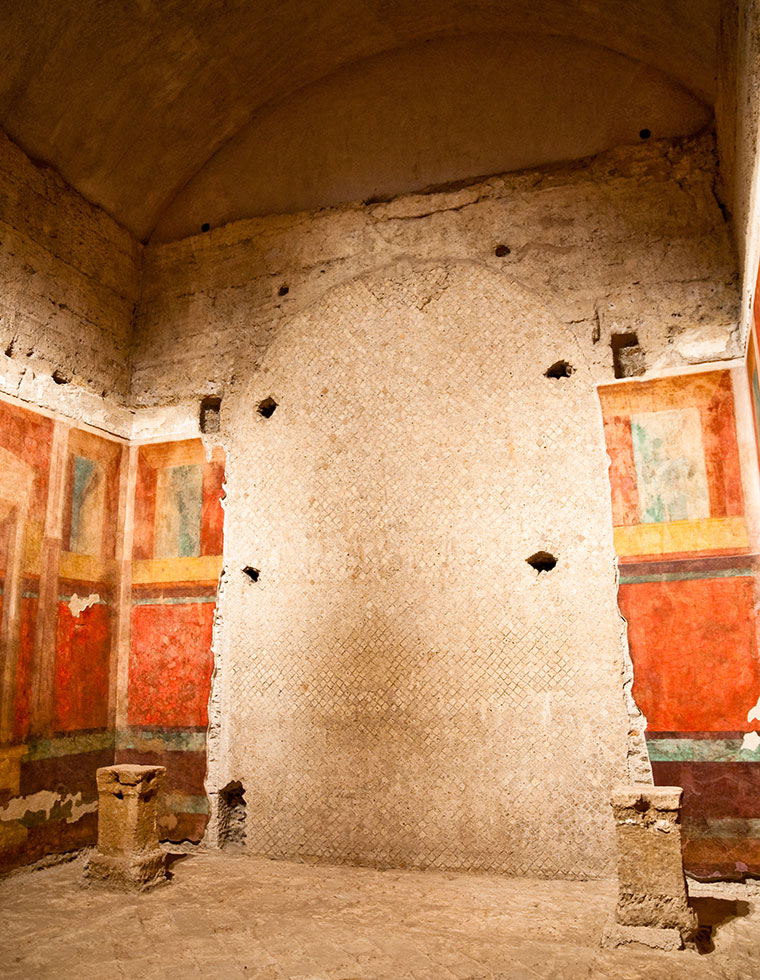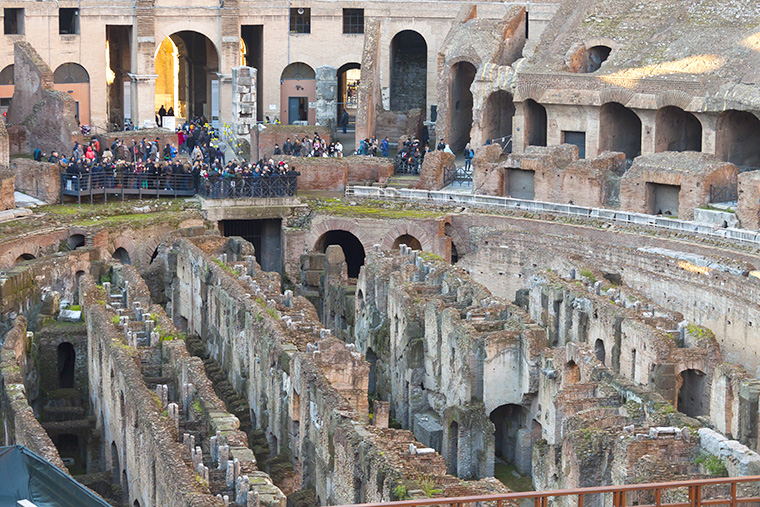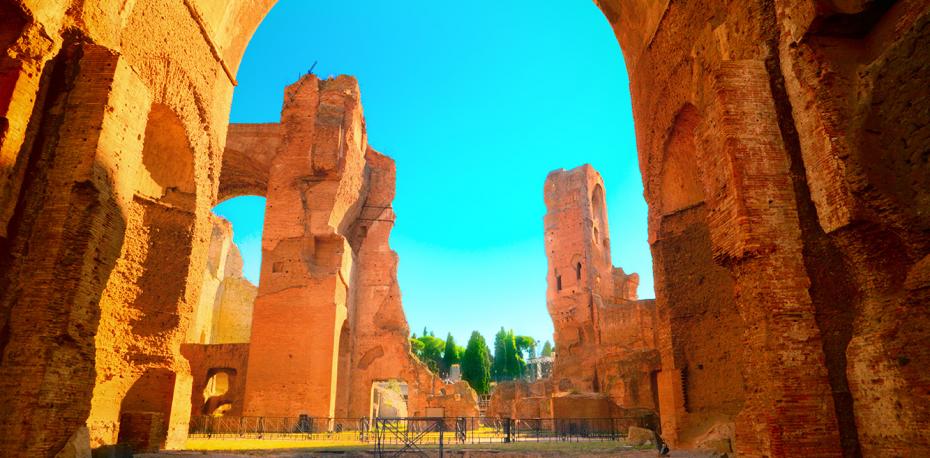Rome is a city of ruins. Ruins are to Rome what canals are to Venice, and while other cities build over their past, Rome builds around it. My neighborhood, Testaccio, is mainly made up of nineteenth century apartment blocks, and it seems almost modern compared to the crumbling centro storico. But on one otherwise ordinary street, a stretch of Roman wall rises out of the ground like the back of a sea monster. The contrast between the modern apartments and the ancient wall is startling when you see it for the first time, but locals walk past without giving it a second glance. It’s just the remains of a 2,000 year old port – no big deal.
When you live in Rome, it’s easy to take the city’s history for granted, but some ruins are more spectacular than others. Some are so well-preserved that they seem to bring the ancient city to life, narrowing the gap between the past and the present, while others are disorientating, even alienating, as their fragmented state makes it impossible to visualise the original building.
Whether you’re on your own or exploring the ruins on a walking tour of Rome, it’s always an adventure. Here are some of the most interesting in Rome, including one that’s off the beaten track.

1. The House of Augustus on the Palatine Hill
The history of Rome began on the Palatine Hill, as it was here that Romulus and Remus were found by the she-wolf. Octavian, the man who would become the emperor Augustus, chose the Palatine for his personal residence because of its legendary associations, and had his house built near the remains of Romulus’s hut.
The ruins of his villa have just been opened to the public, and can be explored on a tour of the Palatine. Augustus had relatively modest tastes for an emperor (or an emperor-to-be), and the house isn’t as large as you might expect, but the art is stunning. The walls and ceilings are decorated with vivid frescoes depicting plants, theatrical masks and mythological scenes. While the building is technically a ruin, the paintings are amazingly well-preserved, having been protected by their burial underground.
2. Domus Aurea
This is another imperial residence, but belonging to a very different sort of emperor. Nero’s pleasure palace dominated the centre of Ancient Rome, covering up to 300 acres. There were hundreds of rooms decorated with gold and ivory, and a dining room with a rotating ceiling. At one of Nero’s more decadent banquets, a guest was apparently smothered to death by the petals that fell from the ceiling. After Nero’s suicide, subsequent rulers tried to bury all traces of the Domus Aurea, and it remained hidden until the fifteenth century, when a young man fell in a hole and was amazed to find himself in the painted ruins of the palace.
Visiting the Domus Aurea today is a strange, slightly unsettling experience. Not many traces of luxury remain, apart from some water-damaged paintings, but as you walk through vast, echoing corridors, you get a good sense of how enormous the palace was. The decadent atmosphere of Ancient Rome has been replaced by the cold, damp air of decay, making it one of the most haunting places in Rome.

3. Underground Colosseum
The Colosseum is the most spectacular ruin in Rome from any perspective. Admiring it from the Capitoline Hill, whizzing past it on a motorino or gazing down into the arena from the top level, it never ceases to amaze. But you haven’t truly seen the Colosseum until you’ve explored underground, walking through the tunnels beneath the amphitheatre. It’s a chance to go behind the scenes, and walk in the footsteps of gladiators, slaves and wild animals. Exploring the spaces where lions were caged and gladiators prepared to make their entrance (through lifts and trapdoors) allows you to see the Colosseum through the eyes of the people who lived, worked and died here. After going underground, you’ll feel you’ve seen the human side of the Colosseum. That’s the beauty of ruins – some old stones can unexpectedly make you feel closer to people who died more than two thousand years ago.
4. Baths of Caracalla
The Baths of Caracalla were the second largest public baths in Ancient Rome. When they were in use during the 3rd-6th century BC, they would have contained a hot room, a cold room, a swimming pool, gyms, shops and a library, and they were decorated with mosaic floors and huge marble statues. During their heyday they must have resembled a cross between an elegant spa and a shopping centre.
The artwork has since been scattered across the country for preservation in museums, but some of the mosaics remain. These days, the most impressive aspect of the Baths of Caracalla is their sheer size. Standing in the shadow of the vast red walls makes you feel very small indeed. The ruins must have been even more spectacular in previous centuries, when they were overgrown with weeds and wildflowers, but the bare red bricks are striking for their starkness.
The theatrical potential of the ruins has not gone unnoticed. The baths appear in key scenes in La Dolce Vita and La Grande Bellezza, and are used for opera performances every summer.
5. Villa dei Quintili
There are lots of fascinating ruins to be explored along the Appian Way, the ancient road that once linked Rome to Brindisi, including the Circus of Maxentius and the Mausoleum of Caecilia Metella. About five miles down the road you’ll also find the remains of the Villa dei Quintili, one of the most atmospheric places in Rome.
This huge villa used to belong to two brothers, until the emperor Commodus had them killed, and then took the house for himself. Centuries later, it’s a labyrinth of ruins – high walls with gaping windows, and dusty mosaic floors that once decorated a grand dining hall.
Now that everything’s open to the blue Roman sky, it’s difficult to visualise it as a house at all, and even harder to imagine imperial banquets taking place in these fragmented rooms. But exploring the ruins, which include baths and a hippodrome, feels like a real adventure. You’re far away from the centre of Rome, and most of the time you’ll have the ruins to yourself. It feels as though you’re exploring this strange, timeless place, which belongs neither to the past nor the present. You could almost believe that there was never a palace at all. Perhaps they were always ruins, waiting to be discovered by the next explorer on the Appian Way.
Alexandra Turney works for Through Eternity Tours.





























